My "Dysfunctional" Dive into Design
plus "before" photos and an interior design poll (help!)
In the late fall of 2018, I was supposed to be setting up a brick-and-mortar massage therapy business in an effort to earn enough money to support my writing habit. Four years later I’m not practicing massage therapy—in fact, I let my hard-earned professional license lapse—and a lot of my work now is digital and centered on ideas, especially around disability and design.
In between 2018 and 20233, there have enough starts and stops to give you whiplash. Viewed through the lens of “executive function,” this is one deeply dysfunctional story, full of failure, fickleness, lack of focus and, perhaps most damning: poverty and dependence. According to theorists of executive function such as Russell Barkley, the entire point of being alive is to be independent and self-sufficient (because there is no such thing as the “common good”); to be dependent and therefore a “burden” is basically a fate worse than death.
For the first half century of my life, this is how I viewed my life and my work: through the lens of compulsory executive function. It was the only benchmark I knew—which didn’t prevent me from a life of spirally meanderings, deep dives down rabbit holes, and serial special interests. No, compulsory executive function didn’t change who I was at my core, it just made me deeply ashamed. And that shame, in turn, largely prevented any of those loops and leaps, the big ideas and dreams inside of me, from blossoming into a body of work that I could share with the world, in the ways I deeply desired to.
Just to be clear: it wasn’t the executive “dysfunction” that held me back. It was, largely, the shame. And it wasn’t polishing up my executive functioning skills that saved me from shame; it was design—which I discovered down a deep and “dysfunctional” (and deliciously ironic) rabbit hole.
In late 2018, I had secured a location for my new massage therapy practice, and was working on a website. Having no idea what was likely to attract attention in the world of websites I started googling what was popular in graphic design. Because it was the end of the year, there were all sorts of articles and videos about graphic design trend, the year in review, and predictions for the one coming up.
One of the trends that kept coming up was a nostalgic return to the 80’s, and in particular something called “Memphis Design,” which is characterized by scattered, bright colors, geometric shapes and bold patterns, and a blurring of the lines between form and function, with objects, furniture and even buildings intended to delight, to tell stories, and to respond as much to emotion and desire as to rational functional needs.




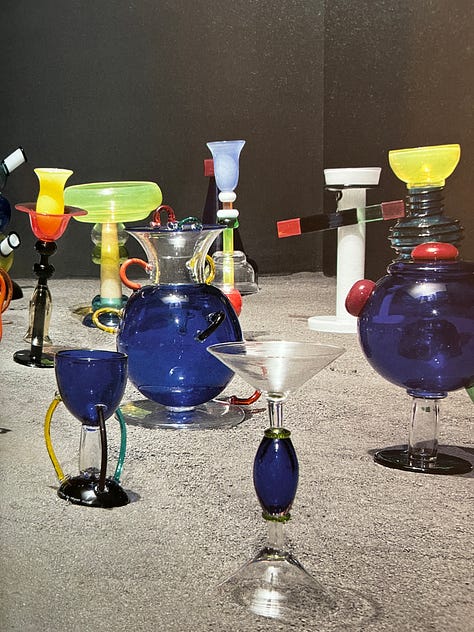

I was intrigued, partly because this design style should have been deeply familiar to me—the 80’s were the decade of my late teens and early adulthood, from ages 15 to 25, a time of life that most normal people are usually up to their eyeballs in popular culture. Of course, I was not “most normal people”—I had totally missed MTV, Peewee’s Playhouse, and Saved by the Bell. I was too consumed with the threat of nuclear annihilation and the promise of intersectional feminism (though we didn’t call it that then); I was busy coming out, deconstructing the patriarchy, and doing AIDS organizing in rural Indiana. I was very very serious, and had little interest in “popular culture.”
I did have aspirations to be a writer, but an artist? Of any sort, much less a designer? That was not even part of my vocabulary.
So while the throwback-to-the-80’s Memphis Design trend predicted for 2019 stirred some very vague visual memories, mostly what it stirred in me was intrigue and a bit of wistfulness, having entirely missed it the first time around. Soon I was deep, deep down this rabbit hole. I had found an aesthetic I liked, but more importantly, through researching the history of Memphis Design (because of course I did!), I had discovered the concept of Design.
And nothing would ever be the same again.
In 2018, I was in the midst of entirely reinventing my life, mostly hanging out with young people who were the age I was in the 80’s—and I often felt like I was in my 20’s again. I was just discovering I was neurodivergent and disabled. I was beginning to understand that digital media platforms (despite all their faults) were an accessible way for me to share all the ideas inside me with the wider world. It was a giddy, creative time of self-discovery, of starting to understand shame and disrupting it. I couldn’t write—I couldn’t even read books anymore—but I started making art. I doodled, I painted, I discovered digital art. I taught myself to edit videos, and taught myself enough graphic design to make eye-catching Instagram posts to accompany the ideas exploding in my brain.
And even while I was doing design, I also kept researching: the history of design, design theory, design thinking. Eventually, I came to understand that design was more than just pretty things, pretty rooms, or even the process of making them—I began to understand design as a paradigm. A paradigm analogous to executive function. A whole way of thinking and being and working in the world that is not especially well-suited to the demands of capitalism, but is, I believe, better-suited to the cognitive styles of many neurodivergent neurotypes.
But unlike executive function, the design paradigm is anything but compulsory; indeed, aside from an elite few, most of us are discouraged, punished and shamed—i.e. disabled—for thinking and working like designers.
This past weekend Joel and I went to see the Matisse in the 30’s exhibit at the Philadelphia Museum of Art, and of course I had to visit the museum design store. And of course, I had to buy some art books (I’m coming to understand that art books are one of my special interest/collections ... though that may just be a fancy justification for spending way too much money on beautiful books I rarely actually read). One book that especially caught my eye turned out to be the catalogue from a 2019 retrospective exhibition on Memphis Design in Bordeaux, France (though I didn’t realize that when I bought the book; it was wrapped in plastic, but I saw those iconic magenta squiggles and the word “Memphis” and that was all I needed to know). 1
I often don’t read the art books I buy, but I am reading the essays in this one, and it feels like coming full circle. I had almost forgotten that Memphis Design was not just an iconic design style that I had missed in the 80’s, but was in fact an iconoclastic design style that was part and parcel of the postmodern critical theory I was doing back then. (I may have missed out on popular culture, but I was knee deep in postmodernism!) It turns out that Ettore Scottsass, the founder of Memphis Design, also viewed design as a paradigm: “as ‘a way of discussing life, sociality, politics, food, and even design.’”2 Scottsass and his motley crew of designers were trying to explode the distinction between form and function, to democratize design and free it from the stifling constraints of modernism:
In 1981, the personalities participating with Scottsass in this veritable think tank shattered the boundaries of modernity, suddenly broadening the range of possibilities. Their creativity sprang from the crisis of ideologies and rationalism; the culture that they were building was a vitalist reaction to the esthetic ossification of the principles of design. The idea of an objective truth was repudiated, replaced by a complex and multifaceted cultural reality. 3
The path from that brick-and-mortar massage therapy business (conceived mostly out of desperation) to this Divergent Design newsletter, and the Divergent Design Studios community (conceived entirely out of inspiration) was hardly linear. Or efficient. It was paved with failure, distraction, and inconsistency. And I’m still not anywhere near earning a living. 4
As viewed through the executive functioning paradigm and its values of productivity, efficiency, and profitability, my work (indeed my life) has been an abject failure. But viewed through the paradigm of design, and by the values that matter to me—beauty, community, liberation, interdependence—this winding, spirally path has brought me exactly where I am most happy to be.
And now for something completely different….
But not all that different, actually, because while this story is a bit more practical, it too involves a winding path with an ambiguous destination (story of my life…).
In early March 2020, I began the planning stages of a redesign of what was then our bedroom, a bland beige room (painted by the previous owners of course; I would never paint anything beige! In the words of my favorite interior designer, Sophie Robinson, #banthebeige). Also in early March of 2020, as you may recall—10th March here in Philly, to be exact—the first official case of COVID was announced. I was pretty sure we were headed for a lockdown, but even I didn’t predict it as early as 23rd March. I thought I was being “on the safe side” when, in the few days before, I bought paint, picture rail moulding, and some upholstery fabric.
What would become “the blue room”—and eventually morph from our bedroom into Joel’s office and a sitting/dressing room—became my COVID19 project. Or at least my first COVID19 project.
It’s still not done. To my credit, other projects—notably the kitchen—are done! But still, it’s time….
Recently I gathered all the materials I need to finally finish the blue room. Mise en place ftw! I even got started on a few things … but then I hit a wall (figuratively speaking). I’ve just been spinning my wheels, unable to put a pin in any one project and just do it. Apparently sometimes even mise en place isn’t enough….
Or rather, I have different mise en place needs right now: it’s not the gathering of materials that is hanging me up, but the gathering of momentum. I simply have none.
Which is where you all come in—would you please tell me where I should start? Here are some photos and a description of what still needs to be done; below that is a poll that is open for one day.
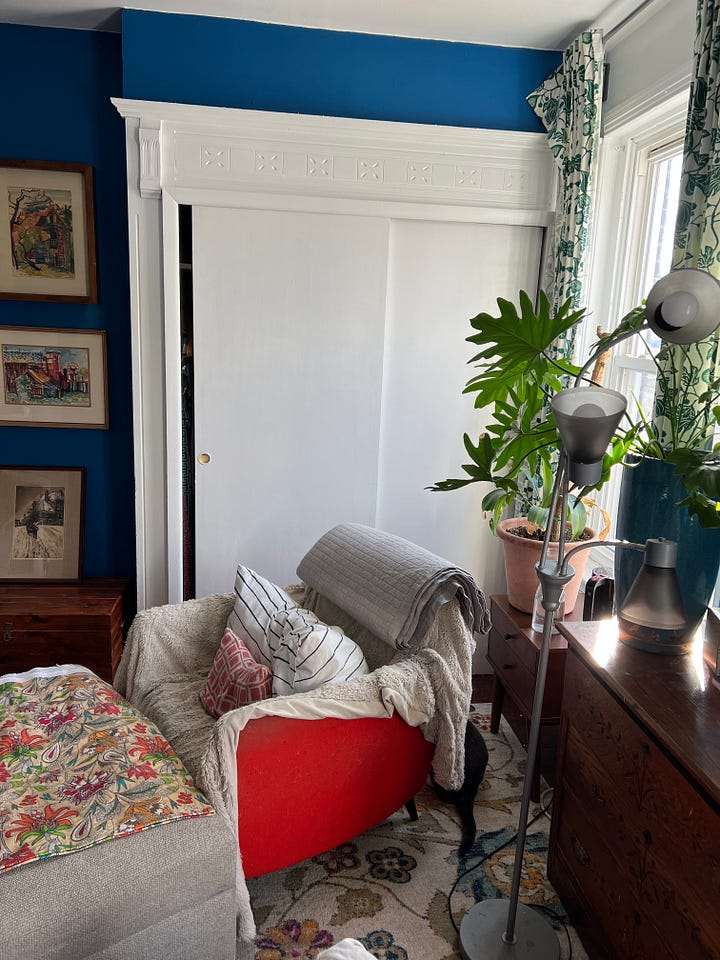
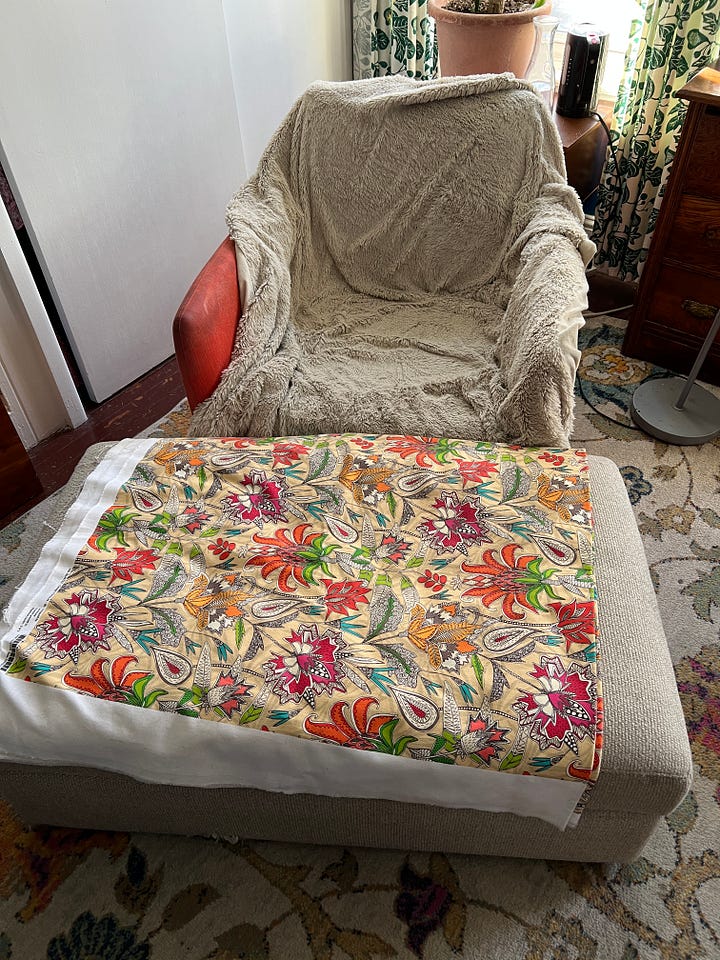
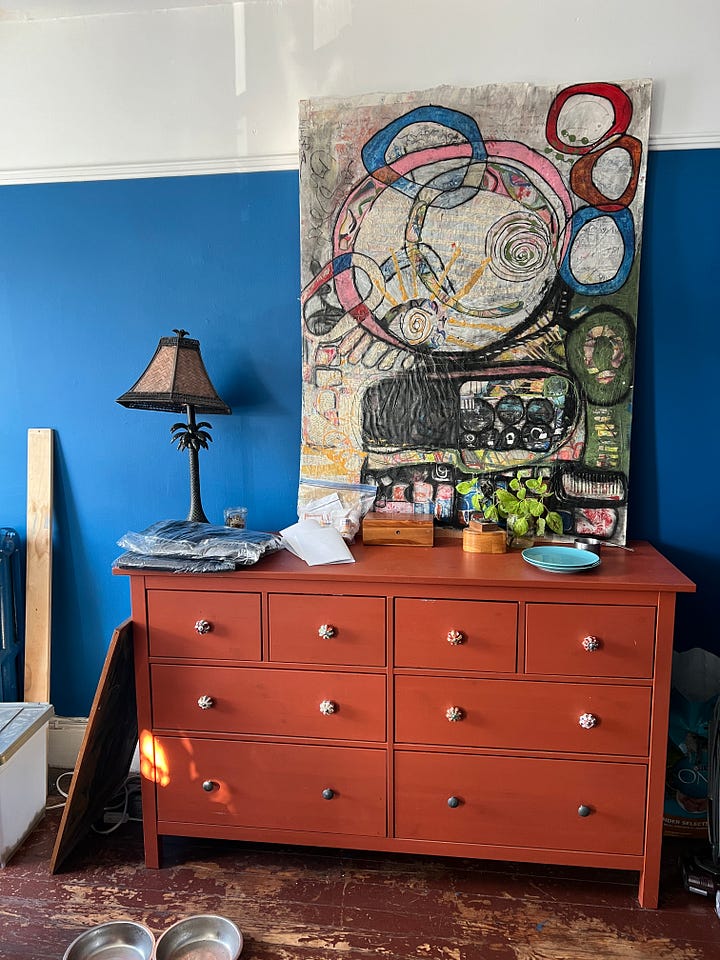
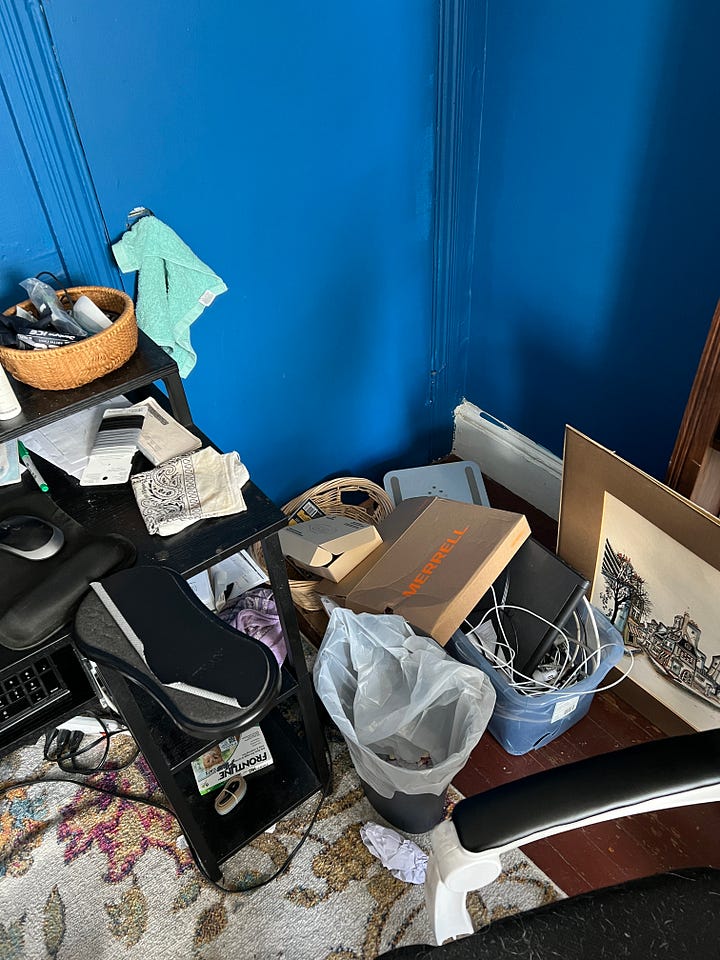
I’ve decided this double sliding closet door is not a nice feature of the room and should not be highlighted by glossy white paint. I’m going to paint it the same blue as the walls, in the hopes that it will “disappear.” I’ve even scuffed up the glossy paint with sandpaper already, and I have new paint and all the tools ready to go. All I need to do is paint—probably two, maybe three layers.
I want to learn how to upholster furniture, and I figure this boxy ottoman will be a fairly simple project to start with. I have the fabric (shown) and all the upholstery tools I think I’ll need. A quick search for a YouTube video (suggestions welcome) and I’m good to go. (I also need to wash the dirty arm of the red chair, which turns out is easy—I’ve already done the other red chair, but for some reason haven’t gotten to this one….)
The third photo is actually two projects: I need to hang that huge painting, as well as several other pieces of art that right now are propped up around the room. I’ve prepped the back of the large painting and have all the stuff I need to hang everything …. but (you see a theme here?) just haven’t gotten around to actually doing it.
The second project in the third photo is that I want to paint a really cool Memphis Design-inspired pattern on that orange Ikea dresser. As with everything else, I have all the supplies and even a digital rough draft of a design.
The fourth photo depicts a mess in the corner next to Joel’s desk, which I really should clean up (but please don’t pick this option in the poll, because I really want to start with something fun!).
Ok, here’s the poll. Please put me out of my misery, and tell me what to do next! (Also, feel free to leave me words of wisdom, advice, or encouragement in the comments; I promise to update you, complete with photos, next week.)
Rubini, Constance, Ed. Memphis Plastic Field. MADD Bordeaux, 2019.
Ibid. p. 22.
Ibid. p. 20.
In 2018, I wasn’t supporting myself, but felt desperate to find a way to do so. In 2023, I’m still not supporting myself—my work is almost entirely financially subsidized by my husband Joel, who told me early on in our relationship that after I had done years of unpaid labor to support my family and community, it was “my turn” to be supported—and that after a rewarding and award-winning 35-year career in community journalism, he wanted to do the paid labor (no longer in journalism, and no longer nearly as rewarding) to support my ideas and my work (even if they never bring in much money).



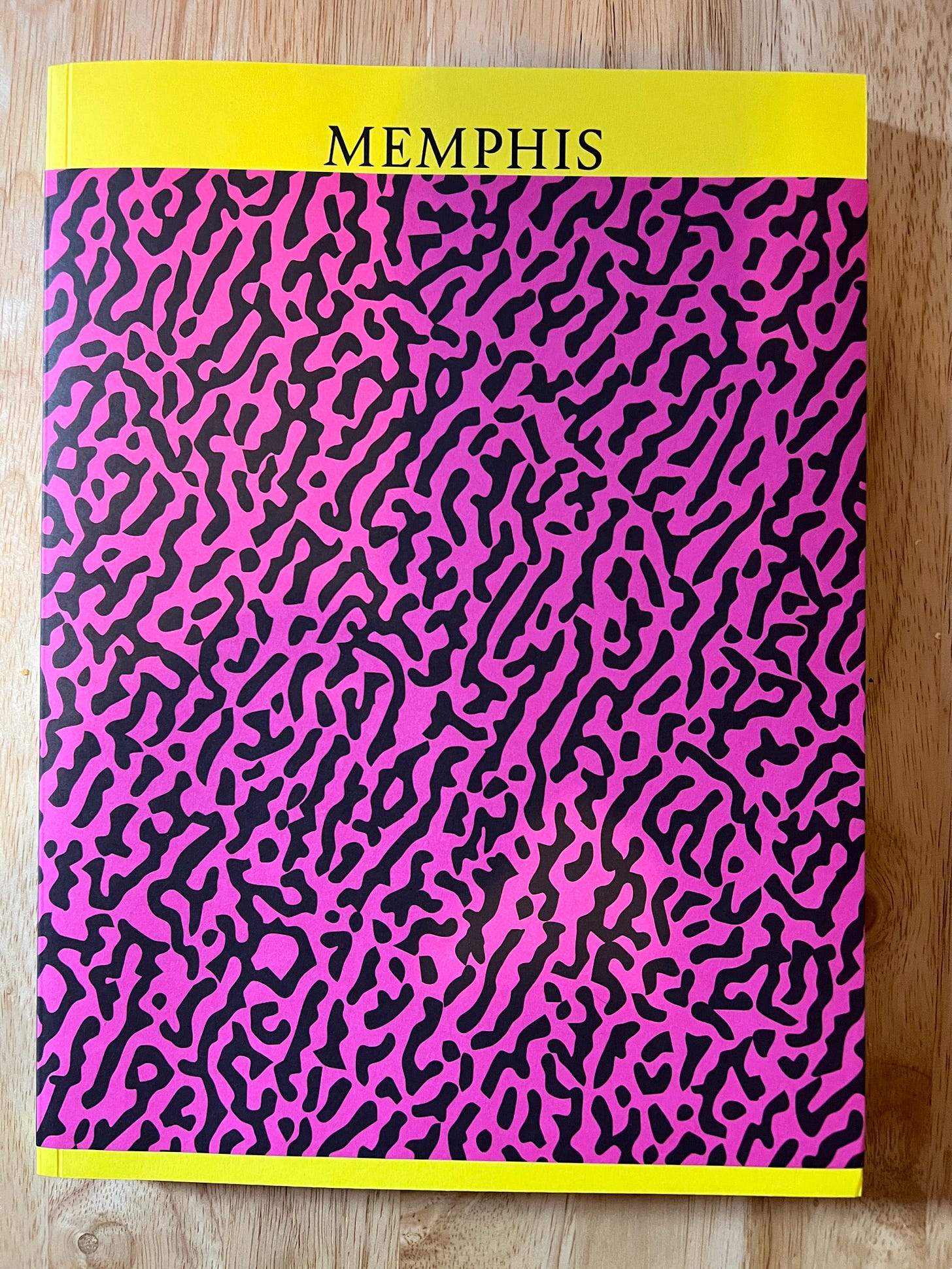
It always takes me AGES to hang art. Then when I do get it done, I’m always like “that was unexpectedly fun.” And then I get the enjoyment of having done some low-stakes math/problem solving, AND the enjoyment of seeing the art that I love that I can now appreciate properly now that it’s displayed, AND the enjoyment of putting in its place something that had previously been clutter/out of place. For me it has the same effect as cleaning the mess in the corner but is way more fun. Then I feel like I have a little more space to stretch out toward the corner mess lol.
I loved reading all of your thoughts in this. I have similar thoughts and experiences but almost always struggle to put them in order enough to make any sense of them. Hearing them from someone else helps with clarity.
I was too late to take part in the poll, but personally would've gone for painting the dresser as it sounds the most fun out of all of them. Or, failing that for lack of activation energy etc., hanging art as a relatively low-energy task that nonetheless transforms the space into something more fun very quickly and hopefully helps gather momentum.
Really, I'm just here to say I'm curious to learn which one you ended up going for. And, of course, to send you some support from one neurodivergent person to another 💚
I really enjoyed reading your thoughts on executive functioning and design (though I'm very much uneducated on the design front) and I appreciate being prompted to think about how I get to design my space, both literal and figurative; that it doesn't have to conform to some beige-ist ideas (beige-ist being a wonderful term I think coined by the wonderful Billy Connolly), it just has to serve my/our needs.
You probably won't remember me, but your Instagram account was one of the first I found when looking into ADHD and your encouraging messages (including DM responses to a very insecure me) on the validity of self-diagnosis etc were a huge help for me when I was mired in self-doubt. Thank you! 🖖🌈🤗